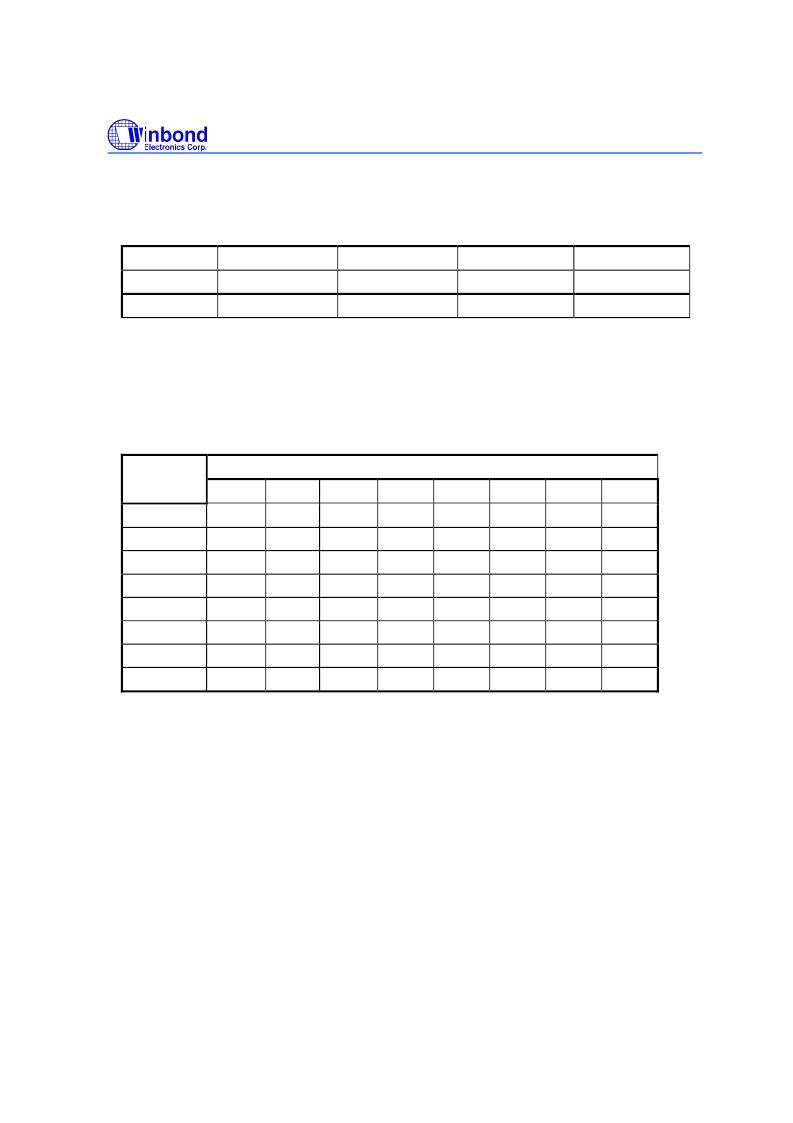- 您現(xiàn)在的位置:買賣IC網(wǎng) > PDF目錄361795 > W89C880F LAN Hub Controller PDF資料下載
參數(shù)資料
| 型號(hào): | W89C880F |
| 英文描述: | LAN Hub Controller |
| 中文描述: | 局域網(wǎng)集線器控制器 |
| 文件頁數(shù): | 19/72頁 |
| 文件大小: | 731K |
| 代理商: | W89C880F |
第1頁第2頁第3頁第4頁第5頁第6頁第7頁第8頁第9頁第10頁第11頁第12頁第13頁第14頁第15頁第16頁第17頁第18頁當(dāng)前第19頁第20頁第21頁第22頁第23頁第24頁第25頁第26頁第27頁第28頁第29頁第30頁第31頁第32頁第33頁第34頁第35頁第36頁第37頁第38頁第39頁第40頁第41頁第42頁第43頁第44頁第45頁第46頁第47頁第48頁第49頁第50頁第51頁第52頁第53頁第54頁第55頁第56頁第57頁第58頁第59頁第60頁第61頁第62頁第63頁第64頁第65頁第66頁第67頁第68頁第69頁第70頁第71頁第72頁

W89C840F
Publication Release Date:April 1997
Revision A1
- 19 -
The following table shows the group mapping relationship between the groups and the contents
of C38/CMA0 and C3C/CMA1. It is obviously shown that each bit in the registers C38/CMA0 and
C3C/CMA1 represents one group.
Bit 31~ 24
Bit 23 ~ 16
Bit 15 ~ 8
Bit 7 ~ 0
C38/CMA0
Group 32 ~ 25
Group 24 ~ 17
Group 16 ~ 9
Group 8 ~ 1
C3C/CMA1
Group 64 ~ 57
Group 56 ~ 49
Group 48 ~ 40
Group 39 ~ 33
All the 48 bits destination address
(including physical address, multicast address and broadcast
address) of the incoming packet will be fed into the CRC generating mechanism. The six most
significant bits of the CRC
(CRC31, CRC30, ... CRC26) will determine
to
which grou
p the
i ncom ng packet bel ongs
. The relationship among these six bits of CRC content and the group that
the multicast address belongs to is shown as the following table.
CRC
CRC28,27,26
31,30,29
111
110
101
100
011
010
001
000
000
grp 8
grp 7
grp 6
grp 5
grp 4
grp 3
grp 2
grp 1
001
grp 16
grp 15
grp 14
grp 13
grp 12
grp 11
grp 10
grp 9
010
grp 24
grp 23
grp 22
grp 21
grp 20
grp 19
grp 18
grp 17
011
grp 32
grp 31
grp 30
grp 29
grp 28
grp 27
grp 26
grp 25
100
grp 40
grp 39
grp 38
grp 37
grp 36
grp 35
grp 34
grp 33
101
grp 48
grp 47
grp 46
grp 45
grp 44
grp 43
grp 42
grp 41
110
grp 56
grp 55
grp 54
grp 53
grp 52
grp 51
grp 50
grp 49
111
grp 64
grp 63
grp 62
grp 61
grp 60
grp 59
grp 58
grp 57
A packet with multicast address which belongs to the nth group will be accepted if the relative
bit of the nth group in C38/CMA0 and C3C/CMA1 is set to high and the bit 4 of C18/CNCR is also set
to high.
Besides the address recognition function, the MAC also performs the frame check sequence
validation function. Each incoming packet data, including the destination address, source address, the
packet data and the 4 bytes CRC data will be fed into the MAC
s CRC generating logic to generate a 4
bytes CRC sequence. The MAC will compare this new CRC data with the one, included in the incoming
packet. It will be recognized as an error packet if these two 4-byte CRC data is not the same,
b
ut the bit
7 of C18/CNCR will determine if the MAC accepts the error packet or not. A high value of this bit will
force MAC to accept the error packet, and low to reject. An incoming packet without byte alignment
will be treated as an error packet. Some packets with the length less than 64 bytes caused by the
collision event on the network are also treated as an error packet. The terminology for the packet with
the length less than 64 bytes is called as runt packet. The extra control bit for accepting the runt packet
is defined as the bit 6 of C18/CNCR. To accept a runt packet, both of the bit 6 and bit 7 of C18/CNCR
should be set to high.
相關(guān)PDF資料 |
PDF描述 |
|---|---|
| W89C840F | 100/10Mbps Ethernet Controller(100/10Mbps以太網(wǎng)控制器) |
| W89C92P | 10M CMOS Coaxial Transceiver |
| W89C940F | 10M PCI-Bus Ethernet Network Interface Controller |
| W91040 | |
| W91212 | Tone/Pulse Dialer With Redial Function(具有重?fù)芄δ艿囊纛l/脈沖撥號(hào)器) |
相關(guān)代理商/技術(shù)參數(shù) |
參數(shù)描述 |
|---|---|
| W89C92 | 制造商:WINBOND 制造商全稱:Winbond 功能描述:PCMCIA ETHERNET NETWORK TWISTED PAIR INTERFACE CONTROLLER |
| W89C926 | 制造商:WINBOND 制造商全稱:Winbond 功能描述:PCMCIA ETHERNET NETWORK TWISTED PAIR INTERFACE CONTROLLER |
| W89C926F | 制造商:WINBOND 制造商全稱:Winbond 功能描述:10M PCMCIA Ethernet Network Interface Controller |
| W89C926PENTIC+ | 制造商:WINBOND 制造商全稱:Winbond 功能描述:PCMCIA ETHERNET NETWORK TWISTED PAIR INTERFACE CONTROLLER |
| W89C92P | 制造商:未知廠家 制造商全稱:未知廠家 功能描述:10M CMOS Coaxial Transceiver |
發(fā)布緊急采購,3分鐘左右您將得到回復(fù)。